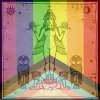Red Sky at Morning
Superstar
- Joined
- Mar 15, 2017
- Messages
- 14,647
Q: What would an ancient deity from Sumer have to do with a month that celebrates all things LGBTQ+?
A: Far more than I had realised till a month ago!
Introduction
This thread relates to the character and worship of “goddess” who in the Bible is called Ashteroth, and later Diana of the Ephesians. In ancient times her month of celebration and parades (accompanied by the sign of the rainbow and cross-dressing devotees) was June.

 vigilantcitizenforums.com
vigilantcitizenforums.com
[for a deep dive]

The Month of Her Possession
Ishtar played a part in other holy days and festivals, but it was this one time of year that her mythology, her passions, her frustration and anguish, her desires and longings, her rituals, and her possession of multitudes saturated Mesopotamian culture for an entire month. It was during those days that her spirit seemed everywhere. It was then that the people of Mesopotamia not only worshipped her but, in their passions, became as her.
They cried out for her lover Tammuz as if it were her crying out through them. They yearned as if it were her yearning in them. They moved in procession as if it were her moving in procession. So the prophet Ezekiel was given a vision in which he saw the women of Israel weeping, as if it were Ishtar weeping for Tammuz. The people became her channels. The goddess of possession possessed them. It was at that time of year that her mythology exerted an amplified power to infiltrate daily life. They were the days when, according to her mythology, she and Tammuz were separated. He was in the underworld, the land of the dead, and she was in the land of the living, seeking to be reunited. Rituals, observances, festivals, and processions dedicated to the goddess and the object of her desire took place throughout the Middle East. One could hardly escape it. During those days, the air was especially filled with her presence.
The Twenty-Nine Days
What would happen if the goddess returned to the modern world? Would she again mark out and lay claim to a similar time of year? Would she again create rituals to be performed during that time, observances to be kept, festivals to be celebrated, and processions to be followed? And would her spirit again especially indwell those days? The answer is yes.
That is exactly what she would do. Upon her return to Western civilization, the goddess set out to mark and lay claim to a space of time every year as her own, a time that her spirit could especially inhabit. As she was the goddess of pride, the time would be crowned with the name pride. The time of the goddess and the object of her passions lasted approximately twenty-nine days. So one month of the ancient Middle Eastern calendar was especially given for the possession of the goddess, her lover, and her mythology. Rites, festivals, and processions took place from the month’s opening to its last day. So the mystery would ordain that the spirit of the goddess would again seek to lay claim to a similar space of time in modern times, one month each year on the calendar of the civilization she was now seeking to possess. And so it happened in exact accordance with the ancient mystery.
Jonathan Cahn, “The Return of the Gods”
A: Far more than I had realised till a month ago!
Introduction
This thread relates to the character and worship of “goddess” who in the Bible is called Ashteroth, and later Diana of the Ephesians. In ancient times her month of celebration and parades (accompanied by the sign of the rainbow and cross-dressing devotees) was June.
“Read this Next” - The Return of the gods
*I have edited this introduction as the topic is far more important than I initially thought… When I first came to this site, the section I carefully worked through was this one “Read this First”...
[for a deep dive]

The Month of Her Possession
Ishtar played a part in other holy days and festivals, but it was this one time of year that her mythology, her passions, her frustration and anguish, her desires and longings, her rituals, and her possession of multitudes saturated Mesopotamian culture for an entire month. It was during those days that her spirit seemed everywhere. It was then that the people of Mesopotamia not only worshipped her but, in their passions, became as her.
They cried out for her lover Tammuz as if it were her crying out through them. They yearned as if it were her yearning in them. They moved in procession as if it were her moving in procession. So the prophet Ezekiel was given a vision in which he saw the women of Israel weeping, as if it were Ishtar weeping for Tammuz. The people became her channels. The goddess of possession possessed them. It was at that time of year that her mythology exerted an amplified power to infiltrate daily life. They were the days when, according to her mythology, she and Tammuz were separated. He was in the underworld, the land of the dead, and she was in the land of the living, seeking to be reunited. Rituals, observances, festivals, and processions dedicated to the goddess and the object of her desire took place throughout the Middle East. One could hardly escape it. During those days, the air was especially filled with her presence.
The Twenty-Nine Days
What would happen if the goddess returned to the modern world? Would she again mark out and lay claim to a similar time of year? Would she again create rituals to be performed during that time, observances to be kept, festivals to be celebrated, and processions to be followed? And would her spirit again especially indwell those days? The answer is yes.
That is exactly what she would do. Upon her return to Western civilization, the goddess set out to mark and lay claim to a space of time every year as her own, a time that her spirit could especially inhabit. As she was the goddess of pride, the time would be crowned with the name pride. The time of the goddess and the object of her passions lasted approximately twenty-nine days. So one month of the ancient Middle Eastern calendar was especially given for the possession of the goddess, her lover, and her mythology. Rites, festivals, and processions took place from the month’s opening to its last day. So the mystery would ordain that the spirit of the goddess would again seek to lay claim to a similar space of time in modern times, one month each year on the calendar of the civilization she was now seeking to possess. And so it happened in exact accordance with the ancient mystery.
Jonathan Cahn, “The Return of the Gods”
Last edited:








